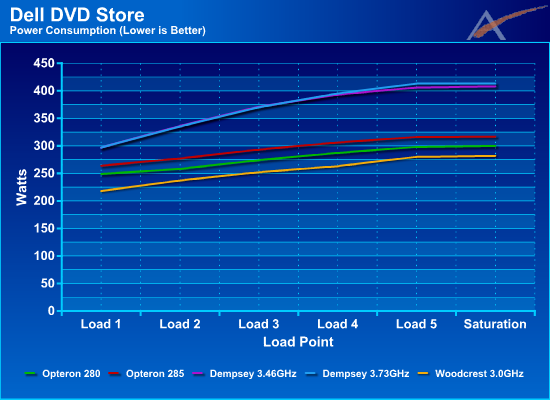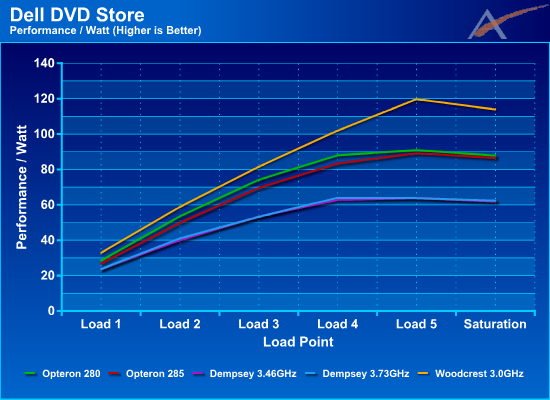Intel Woodcrest: the Birth of a New King
by Jason Clark & Ross Whitehead on July 13, 2006 12:05 AM EST- Posted in
- IT Computing
Dell Test results

At the first three load points all platforms are within 4% of each other. At the fourth load point the spread opens up and Woodcrest leads the Opteron 285 by 5% and Dempsey 3.73 by 6%. Finally, at the fifth load point, Woodcrest is able to lead the Opteron 285 by 19% and Dempsey 3.73 by 27%. It is interesting to note in this graph, and other upcoming performance graphs, that Woodcrest scales linearly to the fifth load point but the others stop scaling linearly between the third and fourth load points.

Woodcrest is clearly the lowest consumer of power and leads the Opteron 285 by 11%-17%, and Dempsey 3.73 by 27%-33%. FB-DIMMs do consume more power than regular DDR2 memory, which partially offsets some of the advantage of the Core architecture.

When we combine performance and power and come up with Performance/Watt we get a very different picture. In this graph we see that Woodcrest is the clear leader at all load points and leads the Opteron 285 by 17% - 34%, and Dempsey 3.73 by 39%-88%. It is also interesting to note that the Opteron 280 outperforms the Opteron 285 on a Performance/Watt measure while Dempsey performance scales almost linearly with power. This often is an indication that the architecture is reaching its clockspeed limits, which is certainly the case as the only faster dual core K8-based chip presently available is the FX-62.

At the first three load points all platforms are within 4% of each other. At the fourth load point the spread opens up and Woodcrest leads the Opteron 285 by 5% and Dempsey 3.73 by 6%. Finally, at the fifth load point, Woodcrest is able to lead the Opteron 285 by 19% and Dempsey 3.73 by 27%. It is interesting to note in this graph, and other upcoming performance graphs, that Woodcrest scales linearly to the fifth load point but the others stop scaling linearly between the third and fourth load points.

Woodcrest is clearly the lowest consumer of power and leads the Opteron 285 by 11%-17%, and Dempsey 3.73 by 27%-33%. FB-DIMMs do consume more power than regular DDR2 memory, which partially offsets some of the advantage of the Core architecture.

When we combine performance and power and come up with Performance/Watt we get a very different picture. In this graph we see that Woodcrest is the clear leader at all load points and leads the Opteron 285 by 17% - 34%, and Dempsey 3.73 by 39%-88%. It is also interesting to note that the Opteron 280 outperforms the Opteron 285 on a Performance/Watt measure while Dempsey performance scales almost linearly with power. This often is an indication that the architecture is reaching its clockspeed limits, which is certainly the case as the only faster dual core K8-based chip presently available is the FX-62.










59 Comments
View All Comments
Viditor - Thursday, July 13, 2006 - link
Thanks Jason...it's just that the power draw is such a central theme to the review, it would be nice to know exactly what and how things were being tested. Could you let us know what features and chipset were on the OEM Woodcrest system?
Cheers
FesterOZ - Thursday, July 13, 2006 - link
JasonBased on your own Extech tests, the 280 you previously tested here http://www.anandtech.com/showdoc.aspx?i=2644&p...">http://www.anandtech.com/showdoc.aspx?i=2644&p... was drawing a max of 265 watts for that database forum test at max load. Now the same CPU seems to be drawing 300+ Watts.
Can you please explain this variation?
johnsonx - Thursday, July 13, 2006 - link
Between the two platforms, the motherboards (Tyan 2882 vs 2891) are different with different chipsets (AMD+AMD vs NVidia+AMD), the software load is different (I presume even at apparent 100% load, there will be small power consumption differences depending on what the software actually does), and there is probably a power supply difference.Those factors combined could easily account for 40 or so watts.
FesterOZ - Thursday, July 13, 2006 - link
Sorry but I really have to disagree here. 40 Watts in a south bridge? Both tests the CPUS were maxed out.Viditor - Thursday, July 13, 2006 - link
Could you be more specific on the Intel OEM system specs? (we can look up the Tyan of course)I assume you used the same PSU for both systems...
Did you measure power draw at the wall?
MrKaz - Thursday, July 13, 2006 - link
Was this review/preview made by Intel?I mean:
-Charts have blue background (a la Intel). (There is one Anandtech symbol in the charts but could be Intel no difference).
-Charts with performance/watts, since when Anandtech review CPU based on those parameters? Never. Why now?
-.90nm CPU vs .65nm CPU - .65nm CPU wins, higher clock, lower consuming. No big surprise here, especially if this processor is derivates from a mobile one.
When AMD releases one socket F Opteron will be interesting, especially if = Intel with just half the cache size and 3 years "old" design on .90nm process.
fitten - Thursday, July 13, 2006 - link
Heh, by your standards then, the Pentium4s should have been faster than all since they are higher clock.
MrKaz - Thursday, July 13, 2006 - link
Intel.http://www.intel.com/performance/server/xeon/intth...">http://www.intel.com/performance/server/xeon/intth...
sprockkets - Thursday, July 13, 2006 - link
65nm smaller than 90nm, I would hope they consume less power. Still, Intel has always been good with power with the P6 derivatives.berat556 - Thursday, July 13, 2006 - link
I am not impressed with this latest review especially when you take into consideration how the intel is a 3.0GHZ processor while the opteron 285 is 2.6GHZ processor. I was so exited about Conroe but this latest benchmark made put my pre-order order on hold to see if Conroe will do what they said it would a 2.67GHZ win vs. a 2.8GHZ. Major bumper, it looks like woodcrest is still behing the opteron, maybe that is why dell still decided to go with AMD after Intel announced the core architecture.